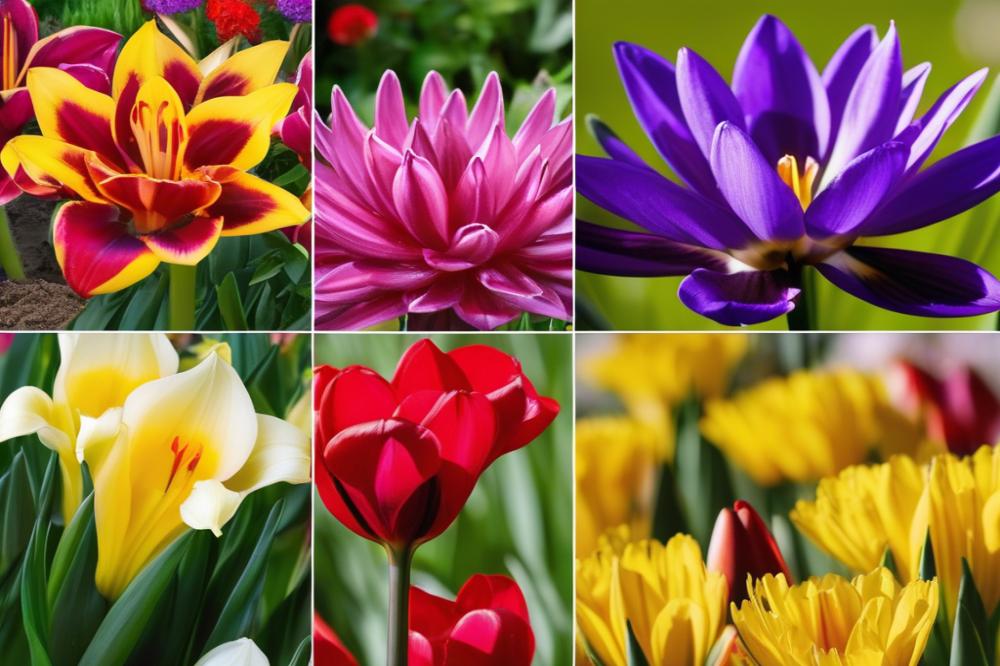Importance of flower bulbs in Gardening
Gardening enthusiasts often cherish flower bulbs for their vibrant beauty and stunning blooms. These remarkable plants bring color and life to gardens, enhancing the outdoor experience. Their variety offers something for everyone, from tulips to daffodils, creating a canvas of seasonal splendor. A successful display not only fills the landscape with joy but also attracts pollinators and promotes biodiversity.
The Role of fertilizers-can-help-combat-soil-erosion”>fertilizers in Promoting Stunning blooms


fertilizers play a crucial role in helping gardeners achieve breathtaking blossoms. Proper nutrient supply can spell the difference between a lackluster garden and a dazzling, colorful vista. Different flowering plants require various nutrients to thrive, and understanding these needs directs how we care for our garden. Choosing the right organic fertilizers can support healthy growth, ensuring that each bulb reaches its potential.
Soil Preparation, Nutrients, and Bulb Care


Soil preparation holds the key to successful planting. The right mix of nutrients in the soil sets a strong foundation for healthy development. Bulb care goes beyond mere planting; it involves regular monitoring of moisture levels and soil condition. Seasonal tips can guide gardeners in maintaining optimal growing conditions. Consequently, these best practices foster impressive growth and vibrant blooms that can be the talk of the neighborhood. Focusing on these elements creates a thriving garden space that will delight for seasons to come.
Understanding Flower Bulbs


Flower bulbs are underground storage organs that contain the essential nutrients needed for plant growth. These structures come in several types, with the most common being tulips, daffodils, and hyacinths. Each type brings its own charm, contributing different colors and shapes to a garden. Knowing which bulbs to plant can enhance the overall beauty of your outdoor space.
The lifecycle of these plants typically involves a period of growth, followed by a rest phase. During the growing season, bulbs push through the soil, emerging as vibrant greenery and stunning blooms. After flowering, the leaves continue to gather sunlight, storing energy for the next cycle. This ongoing process is crucial for ensuring that they thrive in subsequent seasons.
Selecting the right bulbs for your garden is foundational in gardening success. Factors like climate, soil preparation, and timing for planting play significant roles in their development. Healthy blooms require specific nutrients found in the soil, which can differ from one region to another. Organic fertilizers can enhance soil health, helping support flowering plants in their quest for vibrancy.
Knowing the seasonal tips will guide you in when and how to plant. Additionally, bulb care during their growth period can promote stronger plants with more impressive blooms. Different application methods for fertilizers will yield varying results, so understanding how to treat each type of bulb increases your chances of a beautiful display.
Soil Preparation for Flower Bulbs


Quality soil plays a vital role in the health of flower bulbs. Healthy soil impacts nutrition absorption, which is essential for vibrant blooms. Without it, even the best bulb care can fall short.
Testing soil pH and nutrient levels is a crucial first step in soil preparation. This helps you understand if the soil is too acidic or alkaline. Most flowering plants thrive in a pH range of 6.0 to 7.0. Additionally, nutrient levels affect how well bulbs grow. Using soil test kits can provide valuable insights.
When amendments are needed, consider adding organic matter. Compost boosts nutrients naturally while improving soil structure. Peat moss or well-rotted manure also enhance moisture retention. These amendments create an environment where flowers can flourish.
Choosing the right application methods can make a difference in gardening. Mix amendments thoroughly into the soil before planting. This ensures that every bulb has access to the nutrients they need. Seasonal tips suggest preparing the soil a few weeks ahead for optimal results.
Nutrients Vital for Flower Bulbs
Healthy bulb growth relies on a mix of essential nutrients. These components directly influence the development of vibrant blooms. When planting, understanding nutrient needs is crucial for successful outcomes. Key nutrients include nitrogen, phosphorus, and potassium.
Nitrogen plays a significant role in promoting leafy growth and robust stems. It is necessary for the formation of chlorophyll, which plants use in photosynthesis. A rich supply of nitrogen generally leads to lush green leaves, but balance is important. Too much nitrogen can negatively affect flowering.
Phosphorus encourages strong root systems and is vital during the early stages of growth. This nutrient enhances flower formation and can lead to spectacular blooms. Adequate phosphorus in the soil contributes to the overall strength of the plants.
Potassium supports overall plant health. This nutrient helps with water regulation within the plant and strengthens cell walls. It plays a crucial part in resistance to diseases as well as stress from drought or heavy rain.
Micronutrients and Their Significance in Flowering Plants
Alongside primary nutrients, micronutrients also hold great importance. Elements like iron, manganese, and zinc may be required in smaller amounts, but their effects are powerful. Iron supports chlorophyll production, while manganese aids in photosynthesis and nitrogen uptake.
Providing micronutrients can enhance the growth and blooming of flowering plants. Organic fertilizers are an excellent choice for delivering these essential components. Fertilizing methods, such as foliar applications, allow for targeted feeding. This can be particularly beneficial during critical growth phases.
Soil preparation sets the foundation for bulb care. Testing soil can help identify nutrient deficiencies. Following seasonal tips, adjusting nutrient levels becomes easier, ensuring optimal growing conditions. Understanding the nutrient profile of your soil directly impacts the health and beauty of the plants you cultivate.
Choosing the Right Fertilizers
When it comes to preparing for beautiful blooms, selecting the right fertilizers is key. Two primary types exist: organic and synthetic. Organic fertilizers come from natural sources, such as compost, manure, and bone meal. Synthetic options, on the other hand, are chemically manufactured. Both types provide essential nutrients, but their effects on the soil and plants differ.
Organic fertilizers offer numerous advantages for bulb care. They improve soil structure and encourage beneficial microbes. These natural products release nutrients gradually, which helps in steady plant growth and reduces the risk of over-fertilization. Additionally, organic materials enhance soil health over time, leading to a thriving garden environment. The absence of harsh chemicals means a safer option for both plants and the surrounding ecosystem.
Recommended Fertilizer Formulas for Different Bulb Types
Choosing the right formula depends on the type of flowering plants you are cultivating. A balanced fertilizer with equal parts nitrogen, phosphorus, and potassium (N-P-K) works well for many bulbs. For daffodils and tulips, selecting a phosphorus-rich blend can help promote strong root growth. On the other hand, a higher potassium level might benefit glads, enhancing their flowering potential.
During soil preparation, be mindful of how to apply fertilizers. Starting with a slow-release formula right before planting can provide nutrients as the bulbs grow. Liquid fertilizers can also be used as a quick boost during the active growing season. Regular watering aids in nutrient absorption, especially with organic fertilizers.
Seasonal tips can also guide your fertilizing schedule. Early spring is a prime time for feeding emerging plants. However, be cautious not to overload them with too many nutrients at once. This approach ensures that each bulb gets the attention it needs without the risk of burning them out.
Application Methods for Fertilizers
Timing and Frequency of Fertilizer Application
When you’re planting flower bulbs, the timing of fertilizer application is crucial. Begin fertilizing when you plant the bulbs in the fall. This gives the soil nutrients right as they start to establish roots. After this initial application, consider a second application in early spring. This will support the new growth that occurs as the bulbs push through the soil. Regularly scheduled applications every four to six weeks can provide additional support throughout the growing season. Always check the specific needs of the flowering plants you’ve chosen, as some may require different timing.
Best Practices for Applying Fertilizers to Flower Bulbs
Proper soil preparation is essential before planting. Mix organic fertilizers thoroughly into the soil at planting time. This helps improve the soil structure and provides nutrients that bulbs need to thrive. Additionally, sprinkling a slow-release fertilizer around the area can be beneficial. Watering thoroughly after application promotes nutrient absorption. Make sure to apply fertilizers according to the manufacturer’s instructions to maximize effectiveness. Observing your plants as they grow can also guide your fertilizer strategy, allowing for adjustments as needed.
Tips for Avoiding Over-Fertilization
Over-fertilization can harm flowering plants by burning roots and stunting growth. Monitoring soil nutrient levels is a smart way to prevent this issue. Conducting a soil test can provide insights into existing nutrient levels. If you decide to apply fertilizers, start with half the recommended amount. This conservative approach helps in gauging how the plants respond over time. Watch for signs of stress, such as yellowing leaves or wilting. Adjusting your fertilizer strategy based on these indicators can promote healthy bulb care without overwhelming your plants. Keep in mind that less can often be more when it comes to nutrients.
Bulb Care Throughout the Growing Season
Effective watering is crucial for stunning blooms. Water deeply, allowing the soil to absorb moisture before the next irrigation. During dry spells, check the soil’s moisture level regularly. A consistent watering schedule helps strengthen roots and promote growth.
Maintenance Tips for Healthy Blooms
Regular maintenance is vital for overall bulb health. Keep the area around each bulb free of weeds that compete for nutrients. Mulching helps retain moisture and suppresses unwanted growth. Deadhead spent flowers promptly to conserve energy for bulb development.
Seasonal Tips for Fertilizing and Caring for Bulbs
Timing plays a big role in fertilization. When spring arrives, apply organic fertilizers to enrich the soil. Follow up with a second application after blooms fade to support rejuvenation. Timing your fertilization can make a noticeable difference in the health of flowering plants.
Indicators of Nutrient Deficiencies
Recognizing signs of nutrient deficiencies is essential. Browning leaf tips may indicate a lack of potassium. Yellowing foliage often suggests insufficient nitrogen. If these symptoms appear, consider adding a balanced fertilizer that includes adequate amounts of these nutrients.
Addressing Nutrient Deficiencies
When deficiencies are suspected, quick action is important. Adjust the compost and soil preparation practices to boost nutrition. Choose fertilizers that are appropriate for the specific needs of your bulbs. Using the right application methods can greatly enhance growth during crucial phases.
Final Thoughts on Fertilizers and Blooming Beauty
Fertilizers play a vital role in the health and beauty of your garden. Providing essential nutrients helps promote growth and vibrant blooms. Without adequate nourishment, even the most promising bulbs may struggle to reach their full potential. Many gardeners overlook the importance of this step. However, the right fertilizers can be transformative.
Best practices are key for a successful planting experience. Choose a fertilizer that matches the needs of your flowers. Organic options are often gentle and effective, while synthetic ones can deliver quick results. Timing your application correctly also makes a significant difference. Nutrients should be added when they can be best absorbed. Regular maintenance and attention to soil conditions can lead to astonishing displays of color and life.
As you embark on your gardening journey, remember that knowledge is power. Apply what you have learned about feeding your plants. With care and the right techniques, your garden can flourish like never before. Embrace this opportunity to create a vibrant oasis filled with stunning displays. Gardening is a rewarding experience; let your efforts lead to a thriving landscape!



